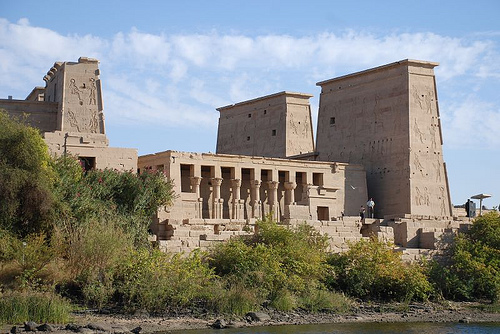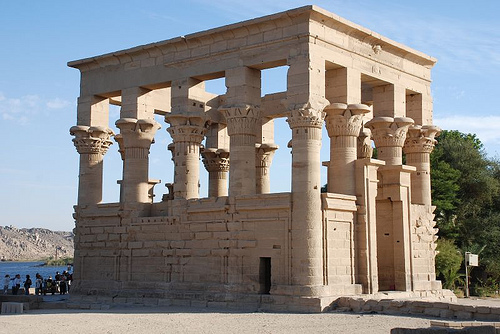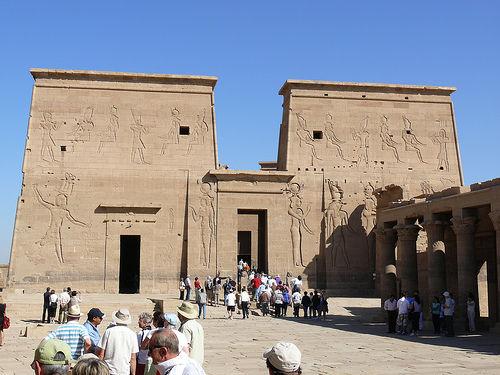

Location: Map

Temples on Philae Island Archaeological Site were built over the course of six centuries, from the 3rd century BC the 3rd century AD. Construction of the Aswan High Dam in the 70's threatened many archeological sites. Philae Island was no exception to that. The island was partially submerged, so in the years 1972-1980 monuments were moved to the island Agilkia. This is why occasionally it is referred as site on Philae Island or Agilkia Island. It is the same destination. The central stage of Agilkia Island is taken by a religious complex of the great temple of Isis from the late period of the Ptolemies. The cult of this Egyptian goddess spread all through the basin of the Mediterranean, including Roman Empire. Many people came here to pay tribute to the goddess and her priests in hopes of good crops and multiple children. Just to the West of the temple the Gate of Handrian stands. One of the last Egyptian hieroglyphs were added to it in 394. Trajan gazebo surrounded by 14 papyris like columns also depict Roman emperor burning incense before god Osiris and his wife Isis. Another Temple of Hathor stands near by with colorful reliefs of Besa, god of song, with numerous musicians surrounding him.

The island is nestled in the body of water between the Aswan Dam and
the old Aswan Dam, built in the early 1900s. The body of water is dotted
with other islets such as Biga (or Bigae, Bige, but in ancient times
also called Senmet) - today partially submerged, it was believed that
the true tomb of Osiris was located there -, Hesa (or Hasa, El-Heisa ,
Geziret el Atik), File and other smaller ones, including Konosso and
Sehel (or Seheil), two other important hieroglyphic graffiti sites.
Through the interest of UNESCO, the Iri/Iritecna Group, through the
companies Condotte Acque di Roma and Mazzi Estero di Verona (later
reunited under the acronym Condotte-Mazzi Estero S.p.A.), was the
implementer, in the five-year period 1975-1980 , of an extraordinary
work: the rescue, with relative transfer, of the sanctuaries of the
island of Philae, in Egypt, to the nearby island of Agilkia.
The
monumental complex of the Abu Simbel temples, built on the orders of
various pharaohs who succeeded one another over time, in honor of the
various divinities worshiped over the centuries, was subject to periodic
flooding of the waters of the Nile River, caused by the opening of the
Aswan Dam in 1902, then elevated (1912 and 1930), finally the Great Dam
(1960-1970), as well as the cyclical floods of the artificial Lake
Nasser.
A project of grandiose proportions, the development and
leveling of the island of Agilkia, which made it possible to exactly
recreate the topography of Philae, a flat island, higher than 12.40
meters, required the use of 150 tons of dynamite to blast 900,000 tons
of rock.
Between 1974 and 1976, the island of Aguilkia underwent major work as
part of the relocation of the temples of the island of Philæ, already
degraded by the rising waters caused by the construction of the old
Aswan dam in beginning of the 20th century and threatened with permanent
engulfment with the construction of the Aswan High Dam commissioned in
1970.
Thus, while its size has already reduced with the rise of
the waters of the reservoir lake of the old Aswan dam, its summit is
leveled by around thirty meters and its coastline is remodeled to give
the island the shape of a bird, the original one from the island of
Philæ. From September 9, 1974 and until 1976, the temples of the island
of Philæ were reassembled on that of Aguilkia which has since been
called Philæ by abuse of language, the islands being very close and
physically similar after the operation.
Posterity
In 2014,
following a competition launched by ESA, Agilkia is the name given to
the landing site planned for the Philae lander dropped on comet
67P/Tchourioumov-Gerassimenko by the Rosetta probe. Among more than
8,000 proposals from 135 countries, it was the name proposed by a
Frenchman who won.